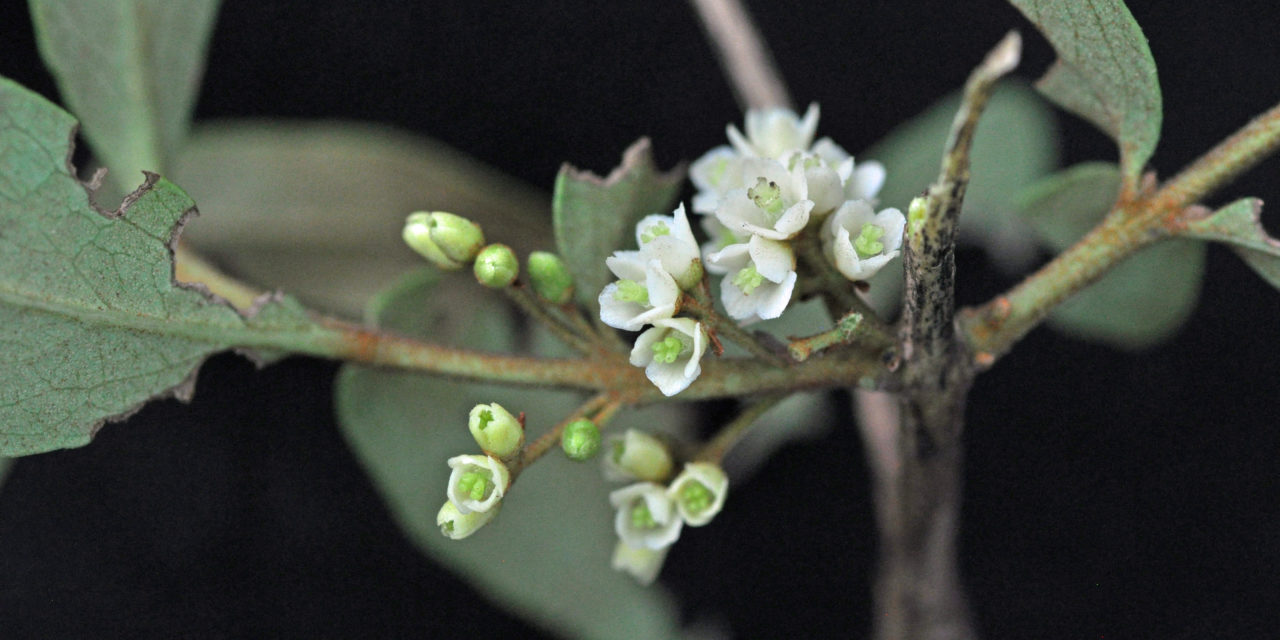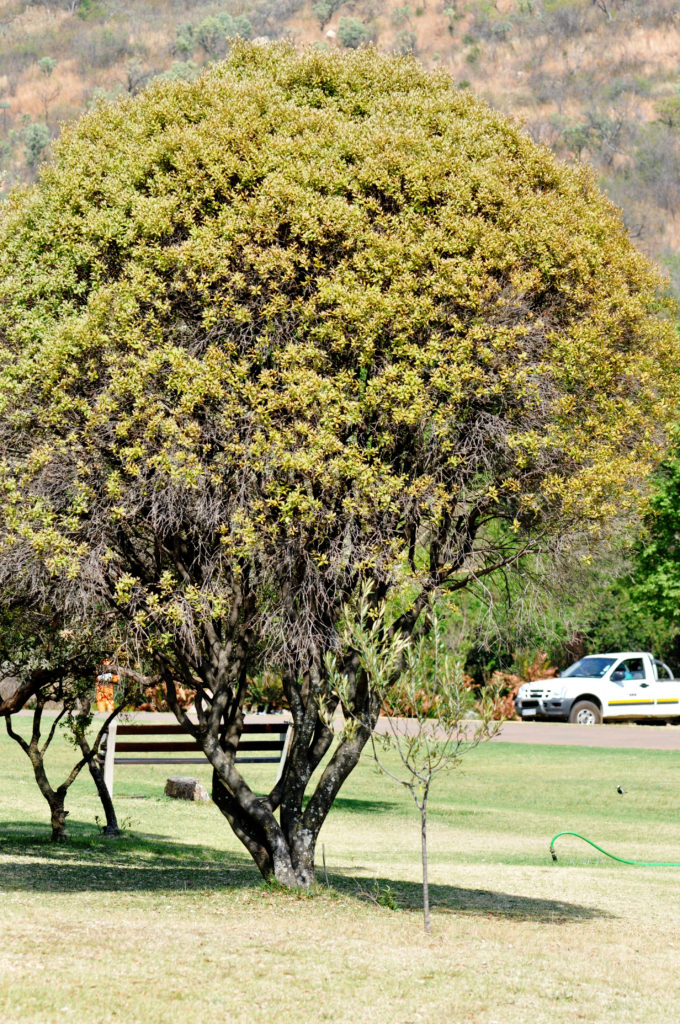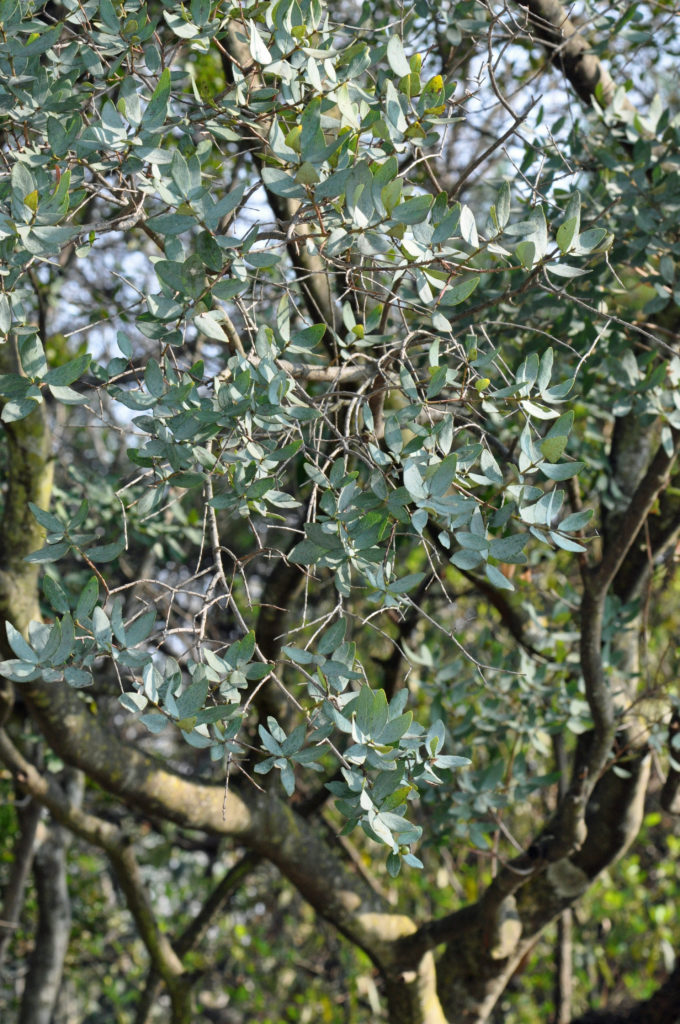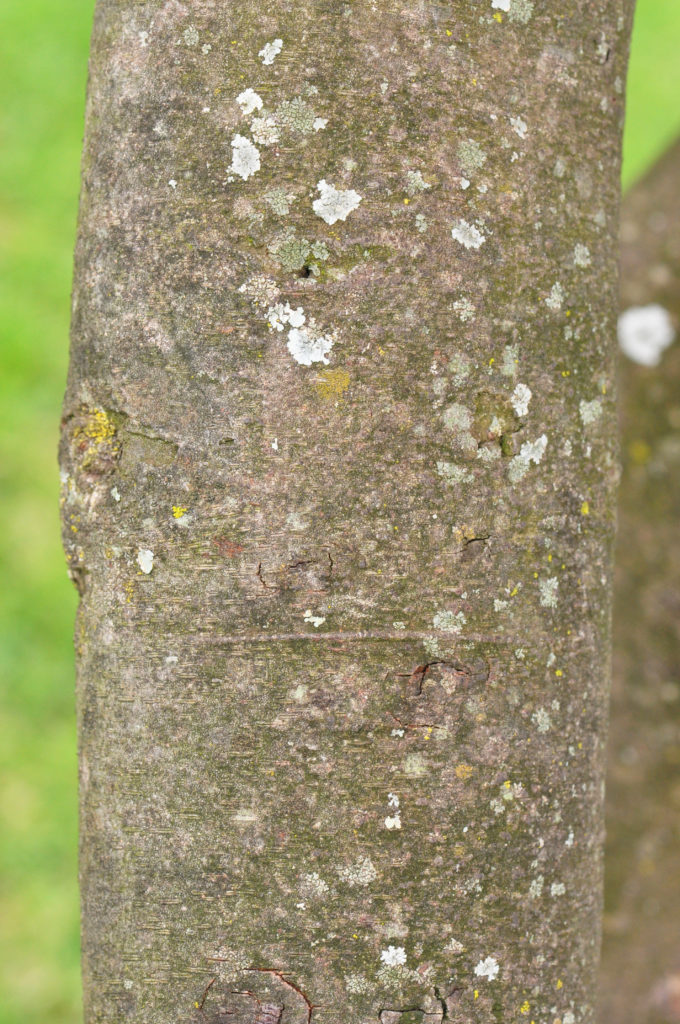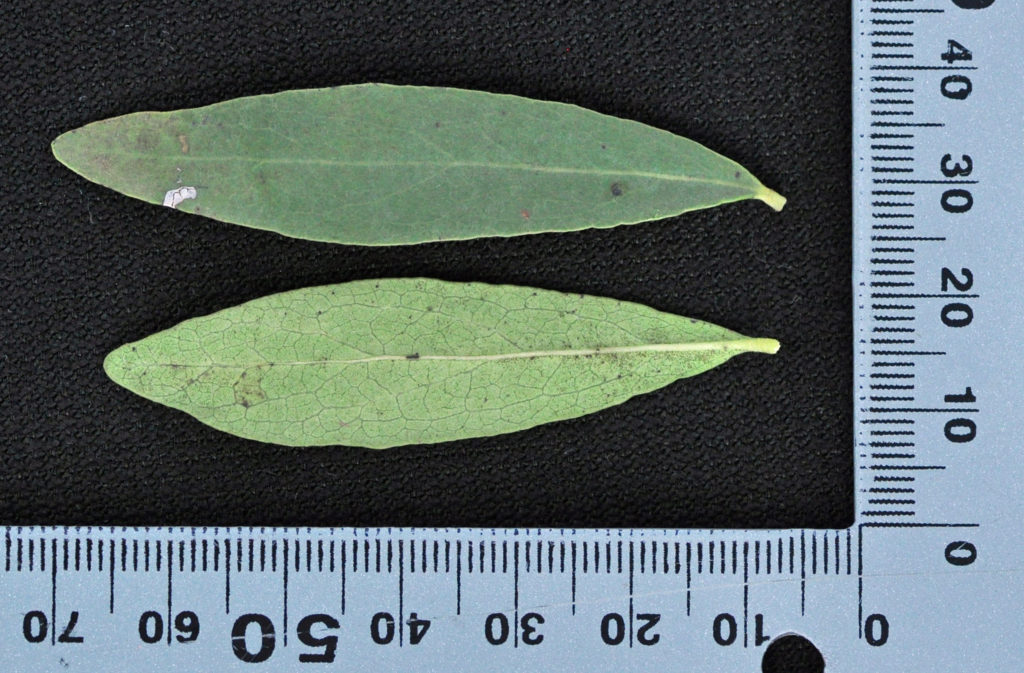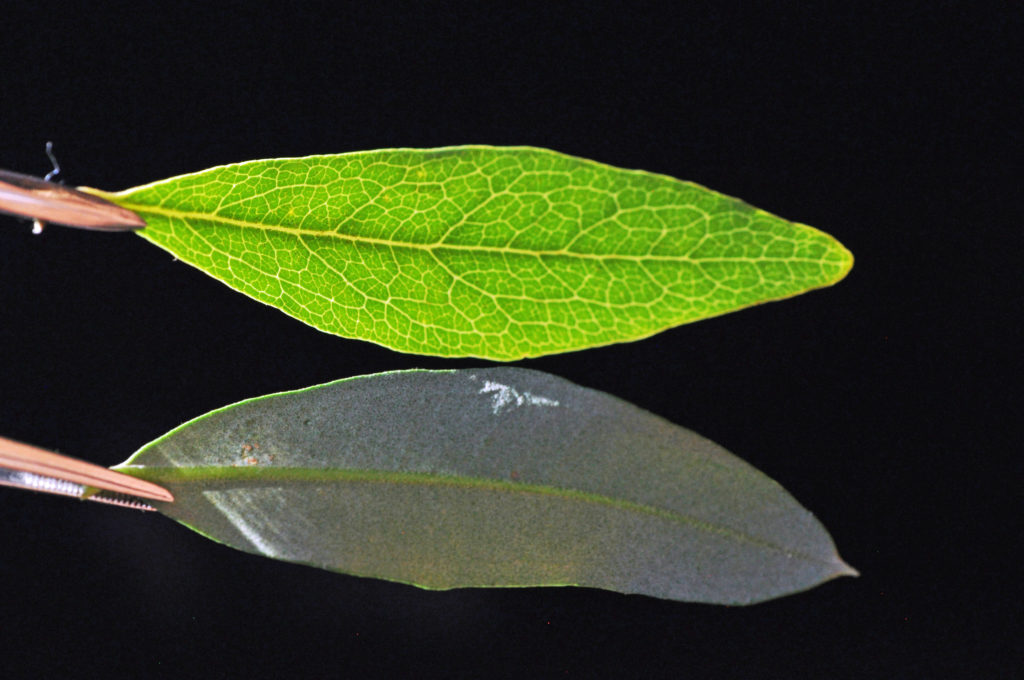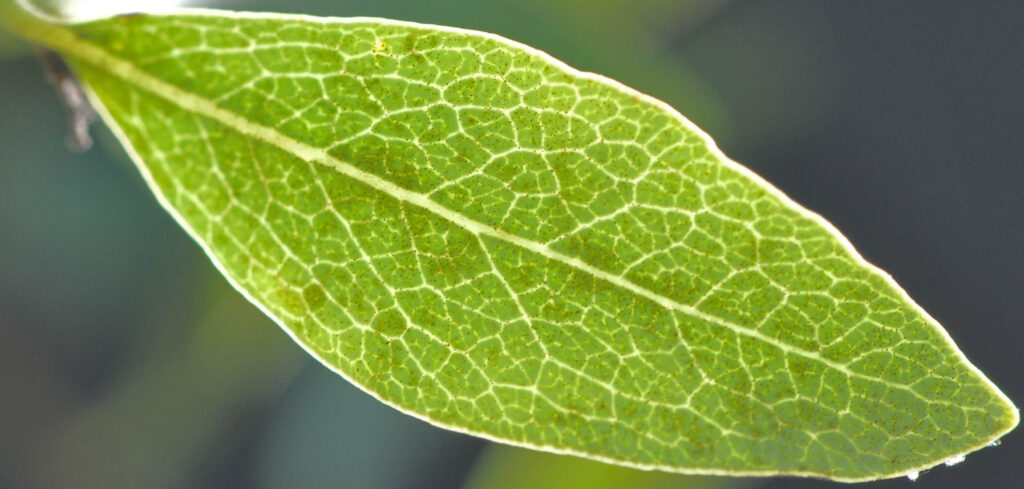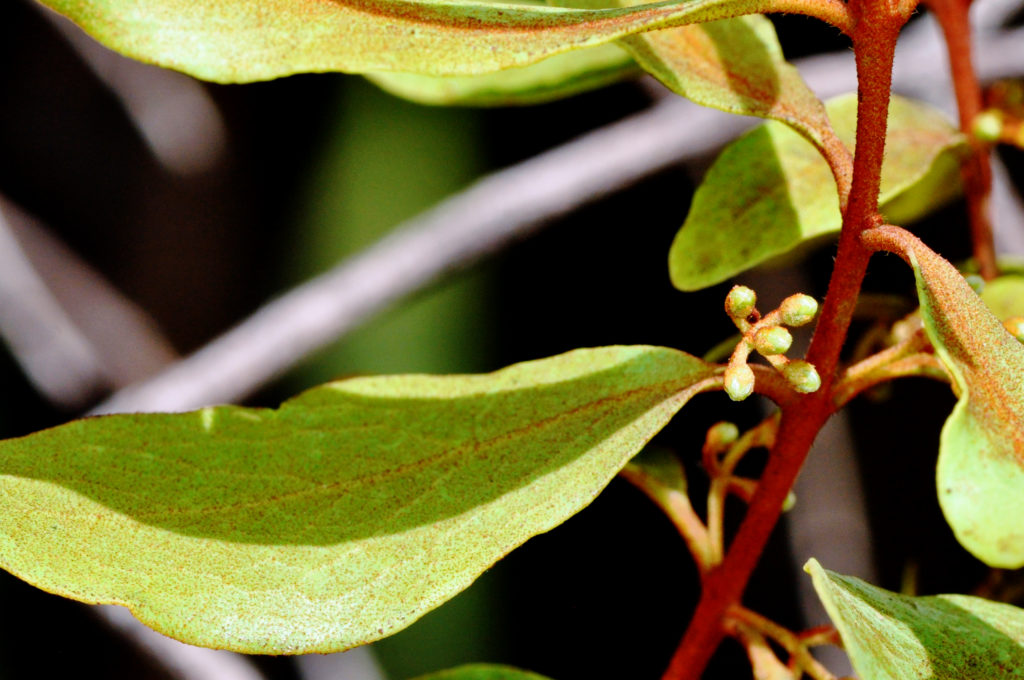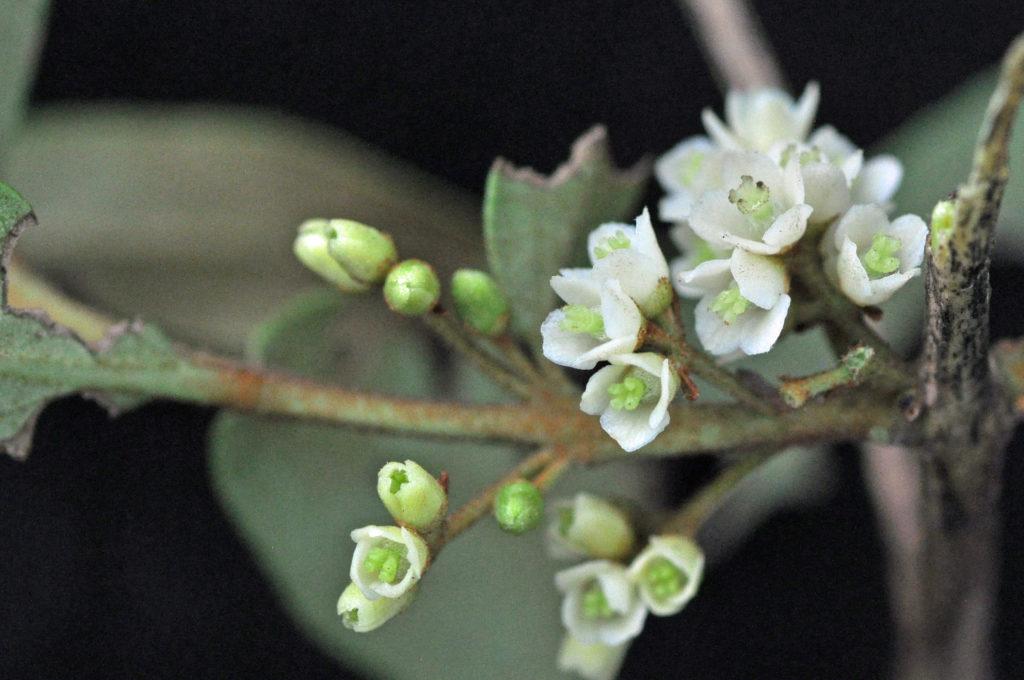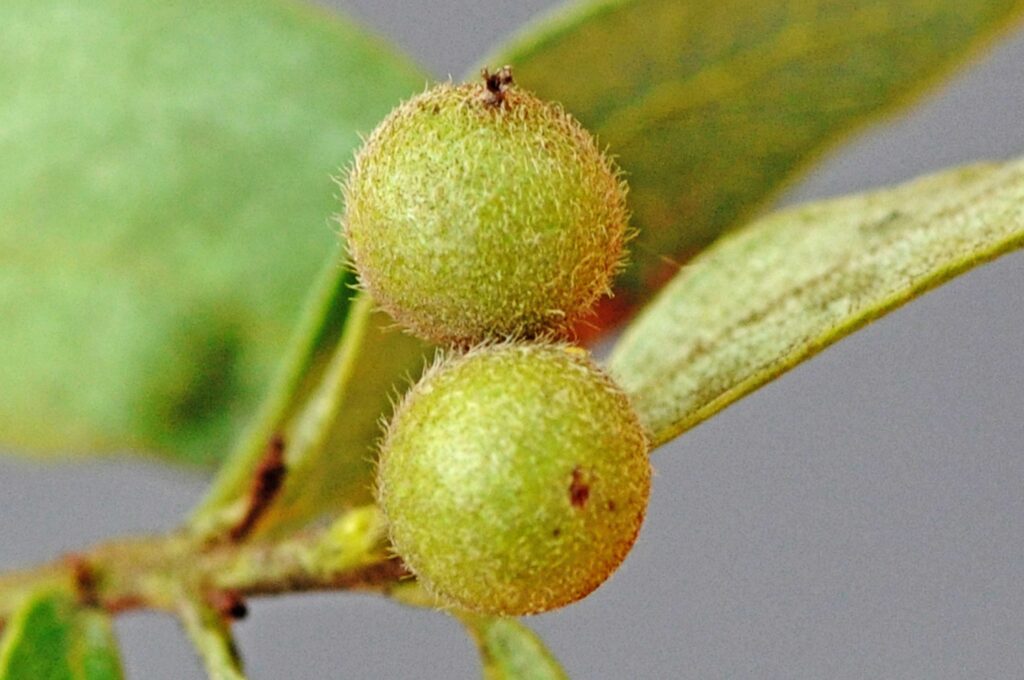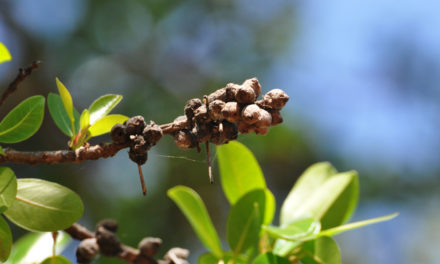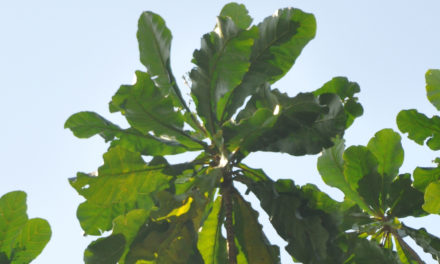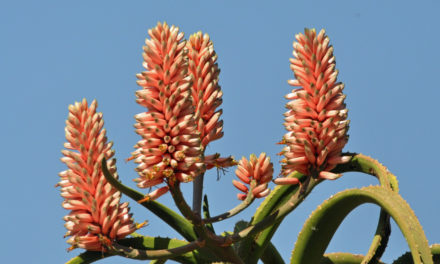General Info – summary
This evergreen, dioecious shrub or Tree may reach 20m high – usually less. Grey/brown smooth bark may become rough & dark brown. Simple, translucent, coriaceous, variably shaped Leaves with entire margins lack stipules. Small regular Flowers are in racemes. Male flowers have 10-18 stamens. Female flowers have a single pistil and staminodes. Fruit is a small round initially hairy stalked berry with 1 globose seed.
Description
Euclea crispa
Previous Names: Celastrus crispus, Euclea bakerana, Euclea baumii, Euclea dekindtii, Euclea guerkei, Euclea lanceolate, Euclea ochrocarpa, Euclea ovata var. glara, Gymnosporia ferruginea.
SA Tree No. 594
Common names: (Afr) Bloughwarrie, Bosghwarrie, Bosguarrie, Bosgwarrie, Guarritee, Gwharrie. (Eng) Blue Guarri, Bush Guarri, Blue-leaved Guarri. (isiXhosa) Idungamuzi, Iyeza lokuxaxazisa, Umgwali, Umtshekisane, Umnquma. (isiZulu) Idungamuzi, Umnqandane, Umshekisane. (Northern Sotho) Mohlakola. (Setswana) Motlhaletsogane. (siSwati) Umdlelanyamatane. (Tshivenda) Mungule-nyele, Munyele, Mutangule.
Family Ebenaceae (persimmon and ebony family). The family has some plants known for their useful wood and others for fruit. Trees are usually located in tropical and warmer temperate regions. There are more than 750 species, in 4 genera, worldwide and the 37 species in South Africa occur in 2 genera (Euclea and Diospyros). The bark and heartwood are black. The simple, coriaceous and entire Leaves lack stipules and are usually alternate or may be opposite, but both may occur on the same plant. The usually unisexual and regular Flowers have a persistent calyx that is often divided near to the base. The corolla usually has a short tube, with Petals fused at the base and extending into overlapping lobes. The basifixed anthers are longer than the filaments. The superior ovary has up to 2 ovules in each locule. The styles may have 2-5 branches. Fruit is a berry with an accrescent calyx, which may dehisce slowly. Young fruit contains tannins and is usually avoided by animals until ripe.
Name derivation: Euclea – glory and fame: referring to the ebony like wood in some species of Diospyros in the family. crispa – refers to the curled or wavy leaf margin. There are about 16 species of the genus Euclea in southern Africa.
Conservation: National Status: L C. (Least Concern). 2005 (W. Foden and L. Potter).
Tree
This variable single or multi-stemmed Tree is usually up to 8m high but may reach 20m. This plant can also be a dense, multi-stemmed shrub. The Trunk may be up to 17cm wide, and the rounded dense Crown may reach 4m wide and is much-branched (photo 17 & 166). The Bark often has harmless Lichens (specialized fungi cultivate algae partners that manufacture food for them by photosynthesis) growing on it (photo 952). With time, the initially smooth grey to brown bark becomes rougher, dark brown or blackish. Young stems are pinkish, purple or reddish (photo 915 under Flowers), angular, and often covered in fine hair (hand lens necessary). No milky sap is present.
- 17. 2014/09/23. Walter Sisulu NBG. Photo: David Becking.
- 166. 2015/08/25. Walter Sisulu NBG. Photo: David Becking.
- 952. 2014/04/01. Walter Sisulu NBG. Photo: David Becking.
Leaves
This tree is evergreen and has coriaceous (leathery) Leaves that are simple (has a single blade which may have incisions that are not deep enough to divide the blade into leaflets). Leaf colour ranges from green, blue-green (in the North West) to grey, and lighter below with rusty scales, at least when young. The position of leaves is sub-opposite (opposite, alternate or spirally arranged) on long shoots. Young leaves may be Decussate (opposite pairs of leaves have successive pairs at right angles to each other i.e., rotated 90 degrees along the stem when viewed from above – photo 915 – under Flowers). There is a great variation in leaf shape and leaves may be lanceolate, oblanceolate to elliptic, or ovate to obovate. Each leaf is up to 9 x 4cm – usually shorter (photo 307). The Undersurface may have rusty scales. Here the Midrib is raised (photo 307). Lateral veins may be distinct, and they may be reticulate (net-like). When veins are not distinct, they are easier to examine against a strong light. This is because leaves are translucent. Using a strong light, the veins appear light yellow (photo 83). By contrast, Olea europaea africana (African Olive) leaves are opaque: see comparison (photo 866). Also in Olea, leaves are more consistently opposite. These differences help to distinguish between the two genera. Leaves may be hairy on both surfaces – especially when young but they may become hairless. The Apex is tapering to rounded (photo 307) and sometimes notched and the Base tapers (photo 307). The Margin is entire (with a continuous margin, not in any way indented) or, occasionally, minutely scalloped. It is slightly or markedly wavy and is often rolled under. The Petiole (leaf stalk) is slender and short – up to 5mm long (photo 307). Stipules (basal appendages of the petiole) are absent.
- 307. 2016/11/08. Pretoria NBG. Photo: David Becking.
- 866. Olea below & Euclea above. 2016/11/29. Walter Sisulu NBG. Photo: David Becking. Leaves against the sun.
- 83. 2015/15/05. Walter Sisulu NBP. Photo: David Becking. Leaf against the sun.
Flowers
The trees are dioecious (unisexual floral structures with male and female parts on separate plants). The very small flowers are greenish to yellow or white (photo 306). The sweet-scented Flowers develop in racemes (a simple, unbranched, indeterminate inflorescence with pedicellate (stalked flowers) along the axis that open in succession towards the apex). Flowers are actinomorphic (Regular, symmetrical. Flowers are vertically divisible into similar halves by more than 1 plane passing through the axis). Only one group of 3-10 flowers is contained as an unbranched spray in the axil of a single leaf (photo 915 & 305). Flowers possess shield-shaped scales and have a fringed, somewhat fleshy Disc (a more or less fleshy or elevated development of the receptacle) in which the ovary is located. The Calyx is not accrescent (does not increase in size with age). In Diospyros the calyx continues to grow after the corolla has fallen). This helps to distinguish between the two. The Corolla has 4 white, deeply lobed Petals (photo 306). In the Male flowers, the Calyx is shaped like a shallow pan with broad to short deltate (triangular) teeth. There are 10-18 Stamens, and the Pistil is greatly reduced and sterile. A non-functional style may be present. In the Female flowers, there is a single Pistil (a unit of the Gynoecium, the female element of the flower, composed of the Ovary, Style and Stigma). The superior Ovary is densely covered with bristle-like hairs, and rests on the slightly fleshy disc (a more or less fleshy or elevated development of the receptacle). The ovary has 4 locules (photo 306) and is covered with tiny hairs. There are about 8 thread-like Staminodes (sterile stamens) present. Pollination is by bees. (Dec-May).
- 915. 2014/10/14. Walter Sisulu NBG. Photo: David Becking.
- 305. 2016/11/08. Pretoria NBG. Photo: David Becking.
Fruit
The small, round, stalked Fruit is a Berry (pulpy, indehiscent fruit like a grape or tomato) which may reach up to 9mm in diameter but is usually smaller. It is thinly fleshy and initially hairy (photo 1203). Here the remains of the single style is are still visible. Fruit changes from green to reddish brown, finally becoming black, smooth and hairless when ripe. The berries are in sprays about 2cm long. Each berry contains a single Seed. (April-Dec).
- 1203. 2015/08/18. Walter Sisulu NBG. Photo: David Becking.
Distribution & Ecology
This tough plant can grow in shade or full sun. The Trees are more common at medium to high altitudes in open forests, forest margins, and deciduous woodlands and even in pure sand. They are also located at the coast and grow close to streams – often associated with Vachellia karroo. Trees also grow in rocky places, grasslands, termite mounds, on forest margins or in the bushveld. In South Africa, the plant is naturally located in the Western Cape, Eastern Cape – close to the sea, Free State, KwaZulu-Natal, Gauteng e.g., north facing slope of Melville Koppies, Limpopo Mpumalanga, and North West. These plants grow on both Waterberg Sandstone in northern Limpopo (alkaline with a high pH value) and Black Reef-Quartzite (acidic with a lower pH value) and plants can tolerate high concentrations of Nickel in the soil. Beyond South Africa, these trees are located in Lesotho, Swaziland, and Mozambique, and northwards into Tropical Africa – including Malawi and Zambia. The thin fleshy-layered Fruit attracts birds and monkeys, and they help to disperse the seeds. Mature plants are frost and drought resistant. The leathery leaves are also fire resistant. They may become infested with scale insects that can secrete a white waxy coating that protects them from some insecticides.
Ethnobotany
The Leaf extracts have some antibacterial action. Wood is hard and close-grained. It is dark brown, and used to make tables and stools. Apparently, it is good for smoking bacon. Berries are edible but not very tasty. A dye is extractable from the Roots and can be used during basket weaving. The sweet-scented Flowers attract bees. Black rhino graze the Bark and leaves. Both male and female trees are required to produce fruit and seeds. New plants can best be grown from recently formed seeds and are fairly slow growing but hardy. However, separate male and female trees are required for fruit production and cuttings from male and female plants is the best way to ensure this. Because of its tolerance of high concentrations of Nickel in the soil, these plants may become pioneer plant in nickel rich soils. Extracted nickel is much used in industry and is a silvery metal with a slight golden tinge. Branches with their fire-resistant leaves are used to beat out small bushfires. The adult evergreen tree provides permanent shade. This plant is widely used in local medicine and the leaves have purgative properties.
References
Boon, R. 2010. Pooley’s Trees of eastern South Africa. Flora and Fauna Publications Trust, Durban.
Burrows, J.E., Burrows, S.M., Lotter, M.C. & Schmidt, E. 2018. Trees and Shrubs Mozambique. Publishing Print Matters (Pty) Ltd. Noordhoek, Cape Town.
Coates Palgrave, M. 2002. Keith Coates Palgrave Trees of Southern Africa, edn 3. Struik, Cape Town.
Foden, W. & Potter, L. 2005. Euclea crispa (Thunb.) Gürke subsp. crispa. National Assessment: Red List of South African Plants version 2020.1. Accessed on 2023/05/22.
Lawrence, G. H. M, 1951. Taxonomy of Vascular Plants, The Macmillan Company, New York. Tenth Printing 1965.
Palmer, E. & Pitman, N. 1972. Trees of southern Africa, Balkema, Amsterdam, Cape Town.
Schmidt, S. Lotter, M. & McCleland, W. 2002. Trees and Shrubs of Mpumalanga and the Kruger National Park.
van Wyk, B. & van Wyk, P. 1997 Field guide to Trees of Southern Africa, Struik, Cape Town.
http://www.plantzafrica.com/plantefg/eucleacrispacrispa.htm
https://en.wikipedia.org/wiki/Euclea_crispa
http://www.prota4u.org/protav8.asp?p=Euclea+crispa
http://posa.sanbi.org/flora/browse.php?src=SP
https://en.wikipedia.org/wiki/Nickel

